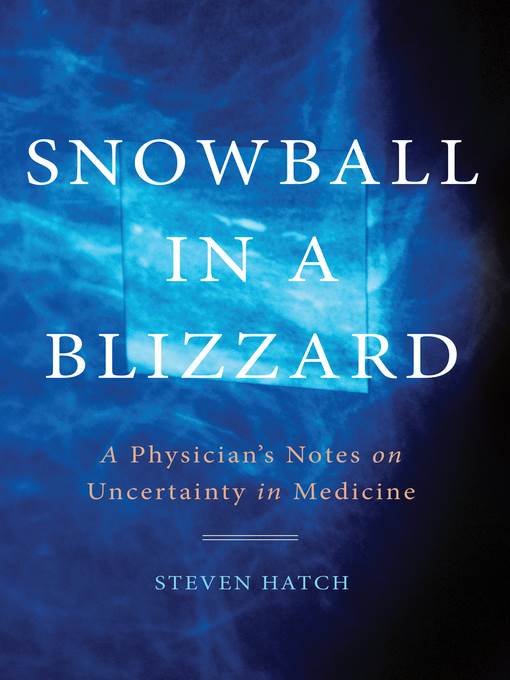
Snowball in a Blizzard
A Physician's Notes on Uncertainty in Medicine
یادداشتهای پزشک درباره عدم قطعیت در پزشکی
کتاب های مرتبط
- اطلاعات
- نقد و بررسی
- دیدگاه کاربران
نقد و بررسی

January 4, 2016
In this carefully argued, unsettling, and important work, Hatch, assistant professor of medicine at the University of Massachusetts Medical School, analyzes how doctors deal with diagnostic ambiguity. Early detection should save lives, yet, unnervingly, as diagnostic tests detect more early disease, death rates haven’t declined. Hatch explains sophisticated technology (ultrasound, the PSA blood test, CT scans) that turn up subtle abnormalities, and why interpreting a mammogram, for instance, is difficult. He discusses the aftermath of a 2009 decision by the U.S. Preventative Services Task Force, which concluded that yearly mammograms are often not lifesaving and are sometimes harmful. They recommended that women between the ages of 50 and 74 have one biennially, though older and younger women could skip it. Their recommendation was unanimous, but so was the outrage from both doctors and women who have ignored it, despite subsequent studies that confirm its validity. Using simple math, illustrations, and vivid anecdotes, Hatch explains that “positive” tests may be vague, and that people yearn for treatments to succeed so much that they tend to ignore evidence that casts doubt. Hatch’s book may prove to be a tough sell because its conclusions contradict human impulses, but it is worthwhile reading for both doctors and patients. Agent: Andy Ross, Andy Ross Literary Agency.

December 1, 2015
An exploration of the uncertainty that lies at the heart of Western medicine. Hatch (Medicine/Univ. of Massachusetts Medical School), an infectious disease specialist, seeks to help patients understand the consequences of this uncertainty. He presents a spectrum of uncertainty, ranging from strong evidence supporting a high confidence of benefit through pure speculation all the way to strong evidence supporting a high confidence of harm. His focus is the middle of the spectrum, the known unknowns, where much of medicine functions. The opening chapters deal with uncertainty in diagnosis, which takes the author into a discussion of the debate over screening for prostate cancers and breast cancers--reading a mammogram can be as tricky as looking for a snowball in a blizzard. In the next section, Hatch considers uncertainty in treatment, including controversies over how to treat hypertension and Lyme disease. The author also examines uncertainty in drug trials, how the media deal with uncertainty in their reporting, and how patients can best use their knowledge of these uncertainties. In writing, Hatch strives to find "that sweet spot where readability and scholarliness overlap." Generally, he succeeds, telling stories that clarify the points he's making, and he even includes a highly personal anecdote that shows him struggling to deal with doctors who were sure they knew the right treatment for his elderly, hospitalized father. The illustrations, however, often seem to have been lifted straight from academic papers and add little to the text. A challenging appendix on the concept of statistical significance provides more information on the subject for curious readers. For doctors, Hatch's message is that it is acceptable to say, "I don't know." For patients, he suggests asking lots of questions and remembering that your doctor should be your guide, not your director. Hatch ably reveals the shortcomings of medicine but is less successful in providing guidance for those trying to find their ways through the confusion.
COPYRIGHT(2015) Kirkus Reviews, ALL RIGHTS RESERVED.

Starred review from February 1, 2016
Hatch, a medical doctor and assistant professor (medicine, Univ. of Massachusetts Medical Sch.), takes a thought-provoking stand in this work that argues that the medical field isn't defined by simple yes-or-no decisions. The foundation of the text is the spectrum of certainty, a scale correlating benefit and harm based on levels of evidence: the stronger the documentation, the more confidence is applied to the physician's decisions. However, since much of medicine functions somewhere in the middle of the scale, Hatch asserts that many interventions and care measures have little to no evidence, or even contradictory proof. Thus, he argues, the majority of judgements are made within at least some level of uncertainty. Chapters focus on overdiagnosis, overscreening, correlation/causation cautions, issues with health statistics, and the media's role in presenting health news. The well-researched findings are supplemented by personal anecdotes from Hatch's practice. The overall message is that medicine isn't as definitive as society may suppose it to be. VERDICT This intriguing perspective on the obscurity of medicine, similar to Atul Gawande's Being Mortal or Jerome Groopman's How Doctors Think, is highly recommended for health-care professionals, health-conscious patients, and well-informed consumer health readers.--Carolann Curry, Mercer Univ. Lib., Macon, GA
Copyright 2016 Library Journal, LLC Used with permission.

February 1, 2016
The concept of uncertainty (and how it impacts the care of patients) is a trendy topic in modern medicine. Medical certainty, according to physician Hatch, is far from commonplace: A diagnosis is, much more often than not, a conjecture, and a prognosis is typically less certain than that. Despite a myriad of medical tests and clinical trials, problems with ambiguities, errors in interpretation of data, and bias besiege the attainment of medical certitude. Hatch writes about overdiagnosis, false-positive tests, doubt regarding diagnosis and treatment, consequences of medical testing, and media hype. Some notable studies and controversial guidelines are reviewed: screening mammography, routine PSA blood measurements, treatment goals for high blood pressure, and hormone-replacement therapy for postmenopausal women. Lyme disease, vaccination, and the continuous creep of prescription medications into the lives of basically healthy people are also addressed. Hatch stresses that honesty and humility are especially good qualities in a physician. And while reassurance is always welcomed by patients, it's okay for even the best doctors to say, I don't know. Or I'm not sure. (Reprinted with permission of Booklist, copyright 2016, American Library Association.)

























دیدگاه کاربران